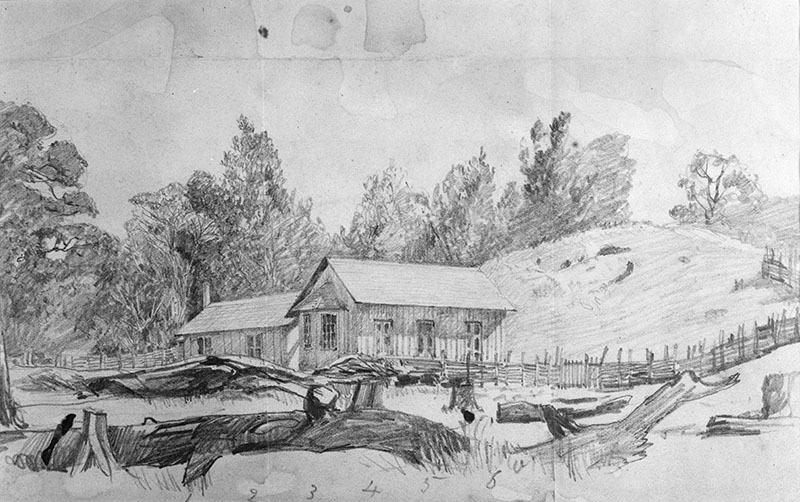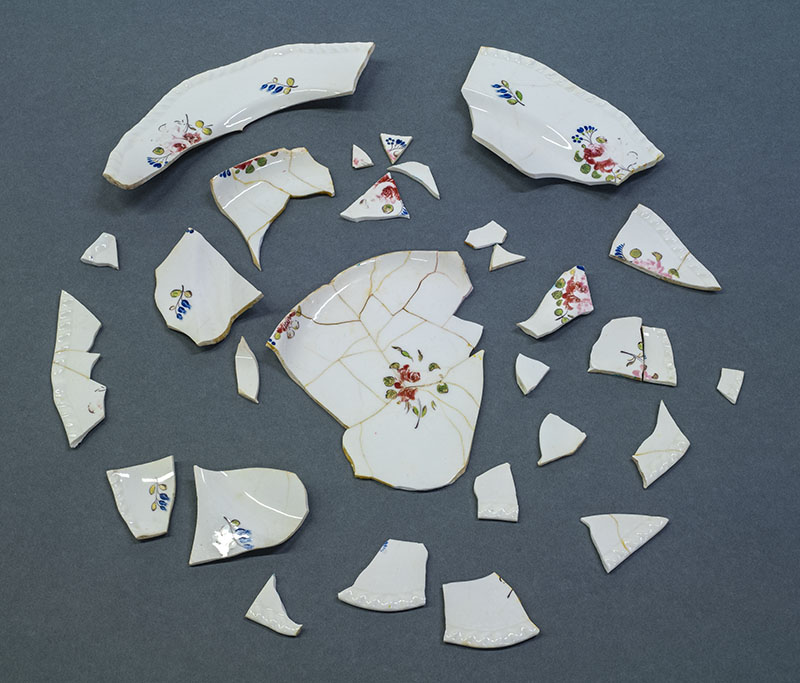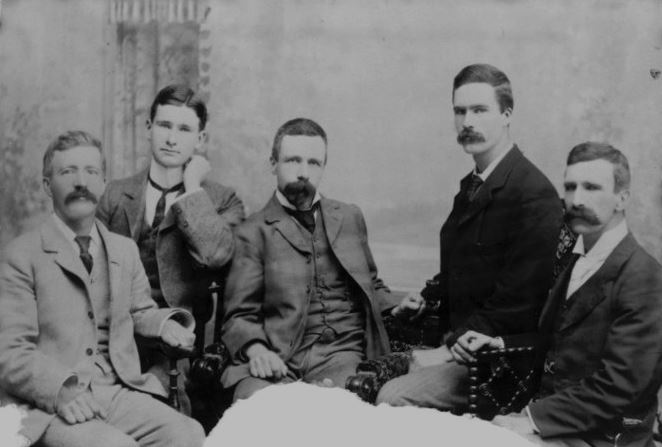





Sir Harry Atkinson was a good keen man. He carved a farm out of the bush, fought in the Taranaki Wars and built a career in politics - climbing from the sawpit to statesman of New Zealand.
A clutch of wooden cottages sit surrounded by flower and vegetable gardens flowing to farmland skirted by thick native bush. Cows graze contentedly in green fields, pigs and hens fossick in the dirt and bees buzz through orchards in bloom. For the residents of Hurworth life was good - they had worked hard and now were reaping the benefits. But the idyllic life wasn't to last. The Taranaki Wars wrecked the little community - the families had to flee and the houses were burnt to the ground by marauding warriors. One house survived; that of Sir Harry Atkinson - the man who had climbed from the sawpit to the position of New Zealand's statesman.
Harry had built the house from scratch - felling the timber, sawing it into planks and hammering in the nails. He'd cleared the surrounding land, planted a garden, raised animals - even become involved in local, then national politics - becoming New Zealand’s first career politician - basically, Harry Atkinson was the perfect colonist.
Born on 1 November 1831 at Broxton in Cheshire, England, Harry Albert Atkinson's early life was a perfect preparation to life in a new colony. The seventh of 13 children of John and Elizabeth Atkinson, Harry was born into the uneasy classes of mid-Victorian England.
His father was a stonemason and architect who brought up his children to be independent and self-reliant. He encouraged his children to grow vegetables and raise animals for sale - the profits were their pocket money. The children were mostly home schooled by their father.
Elizabeth read Dickens and Thackeray to her children, introduced them to a wide range of classical and modern writers and took them along with her to visit the poor and needy. Intellectually the children were also encouraged to think for themselves. Their parents urged them to visit all the churches in the neighbourhood and choose their own. Harry and his younger brother Arthur became Anglicans.
Harry was a deep thinker - a self-sufficient boy who didn't have many friends outside of his family. He and younger brother Arthur were best friends throughout their lives. Their elder brother John had met James Richmond while working on the railway. They became great friends and a close relationship between the families developed. The Richmond’s and some of their Hursthouse cousins had decided to immigrate across the world to New Zealand. When William Atkinson left for the colony in 1849 Arthur and Harry were determined to follow.
Although he didn't approve of the decision, their father wanted to ensure that the boys equipped themselves with the skills needed in a colony that was just finding its feet. He sent the teenagers to learn surveying from their brother John, then the basics of other trades: cobblers, blacksmiths, gardeners and tailors. Harry made his father a suit of clothes and together the brothers built ‘New Zealand House’ in the back garden. The prefabricated house was going to travel with them to New Plymouth - but was left behind as there was plenty of timber to be found in the new colony.
They studied philosophy, theology and economics and books on how to be good colonists - all in preparation for the isolation of the Taranaki bush.
Finally in November 1852 the group of 10 emigrants left England on the Sir Edward Paget: C.W Richmond and his wife Emily, Jane Maria Richmond, Harry and Arthur Atkinson, Charles and Calvert Wilson and two friends of the Atkinson’s, Edward Patten and James Brind. The families were later to be known as the clan or the mob and became a powerful force in the little settlement of New Plymouth. In total five Richmond’s and seven Atkinson’s came to Taranaki.
The journey should have taken four months - but the Sir Edward Paget did not reach Auckland until May 1853 - a weary six months later. During the journey the fractious captain quarrelled with crew and passengers, he and Harry just did not see eye to eye. They argued about food, charges that Harry was trying to incite the crew to mutiny, stopping of rations and trying to prevent the Atkinsons who were travelling intermediate class, from mixing with the Richmond’s who were cabin class.
New Plymouth was small but had everything the new arrivals would need - two churches, two chapels, taverns, a hotel and a jail. The town boasted three flour mills, a bakery, a tannery, several breweries, shops and rows and rows of little cottages. There were six schools and the first issue of the Taranaki Herald newspaper had run off the press just a year before.
The arrivals took the new life in their stride, putting their newly learnt skills to use, adapting to change and embracing colonial life. They weren't penniless immigrants - but expected to have to make their own way.
Harry set to work immediately - his first job was an order from the local cobbler for six dozen pairs of boots. He also found work as the under-man in a saw-pit for which he was paid eight shillings for every 30 metres of timber.
By the end of 1853 the clan had bought 100 hectares of land on the Grey Block 10 kilometres out of town and built 3 kilometres of dirt road to connect up with the road from New Plymouth. The little settlement was christened Hurworth after the town in Durham, England, where Arthur was born. Eventually the area grew to 250 hectares of land.
In 1854 Harry wrote to his aunt: "It is rather rough work at first in the bush. You have to make yourself a small hut of poles and thatch with nikau, light a good fire in the middle and at night roll yourself up in your blankets, then possessing a contented mind you fall asleep and dream of the days when the mighty forest will have given way before the axe and the fire to beautiful green fields and 'homes of ancient peace'…"
Harry had other dreams too - of a little cottage among the green fields, a garden surrounded by a white picket fence and a wife and family to share it all with. Once his house was built (and named Hurworth) and the farm was beginning to find its feet he set about finding himself a wife.
In November 1855 Amelia Jane Skinner arrived from England, accompanied by another Atkinson brother, Decimus. The daughter of a Rochester banker, Jane was a quiet young woman "very pretty with a sweet oval face and demure ringlets" wrote Arthur's new wife Jane Maria Richmond. "She takes to the life very well. She is a capital nurse and makes unexceptionable pies and puddings. Hal has been giving her some lessons in ironing shirt collars…"
The couple were married at St Mary's Church on 25 March 1856 by Reverend Henry Govett. It was a modest colonial affair in the little stone church below Marsland Hill. St Mary's had been built 10 years previously, making it the oldest stone church in New Zealand.
The guests, a small cluster of family and friends, then assembled for a lavish wedding breakfast. "I was really astonished at the brilliant effect of the breakfast table" wrote Jane Maria. "Everything on it except the bride cake and two pork pies were prepared at home by Nellie and me, but all our best china, crockery, glass and plate, the latter in a state of great brilliancy, set off with flowers, made it quite superb. We sat down twenty two…had a most spirited dance in the evening."
The last the guests saw of the happy couple was: "Hal on Griselda and Jane on Polly at a canter going up to their bush home. They were lost to sight behind the pura puras - 'Cassy' in a kit slung over Hal's shoulder."
Harry and Jane's child Harry Dunstan was born in February 1857, followed by Edmund, Frances and a third son, Alfred. Life at Hurworth was good - the rest of the clan built houses nearby and there was plenty of hard work, fun and laughter in the little settlement. There was always something happening: on Sundays a church service at either Harry or Arthur's, a debating group, singing class, German class, theatrical productions, dancing, cricket matches, race meetings and large family dinners. "There is certainly no slowness in life here, for with such a wide family connection something exciting or interesting is always going forward" wrote Jane Maria. J.C Ricmonds house had been dubbed The Palace of Art, Harry's Kai Kai lodge and Henry's Damper Hall.
The economic situation was good and all the Hurworthians were enjoying a high standard of living. Harry employed two men and was something of an entrepreneur. "He is the Hurworth carter, has bullocks, cows, rears calves, pigs, turkeys, ducks, fowls… makes butter and is shortly going to be cheesemaking." Before long he was also supplying firewood to the troops stationed in Taranaki and had a contract to carry mail between New Plymouth and Wellington. "New Plymouth," he wrote to an aunt in 1854, "is a most jolly place, and has more than fulfilled my expectations in all respects."
Besides farming and fun, the clan's big interest was politics - they all felt an interest in public affairs was a duty. In 1857 when Harry was elected to represent the Grey and Bell constituency he told C.W Richmond he went to “speak for the bush”. Like most immigrants Harry saw things in terms of land development and believed the “savage” Māori should be suppressed and eventually absorbed into the superior British way of life. Land was the primary goal and if Māori had to be intimidated, or even fought, then so be it. Years later in 1879-1881 when Parihaka became an issue, he was a supporter of the detention of prisoners without trial and a show of force in Taranaki.
The Taranaki War in 1860-1861 changed the idyllic life at Hurworth. Harry, like everyone else, moved his family to safety - Jane and the children went to Whanganui. It was to be five years before Hurworth would see a family in its midst again and in much different circumstances.
Much had happened in the interval. At the outbreak of war Harry had been appointed Captain of the No 2 Company of the Taranaki Rifle Volunteers. He fought at Waireka and Māhoetahi during the First Taranaki War and organised a force of 50 Bush Rangers in the Second Taranaki War. This force called themselves the ‘gorillas’ and were the first Forest Rangers in New Zealand. Harry had risen to the rank of major and had been minister of Defence in F.A. Weld's government.
Harry and Arthur returned to the little settlement of Hurworth in 1861 to find it destroyed. Hurworth Cottage was the only building standing - everything else had been reduced to ash. In the cottage the furniture had been piled up and set fire, but it had not taken, and the building survived. The place was a mess: cattle had been stolen, the gardens ransacked and general chaos reigned.
In the desperate flee from their homes the Hurworth families had been unable to take everything with them, so buried some treasured possessions under a tree. When the buildings were destroyed so was the surrounding bush and the hiding place seemed lost forever.
Harry wrote: "We went to our place, drank to our next merry meeting and had dinner on the little hill. After that I dug to find the buried crockery until we started to go back but did not hit on the right place." The crockery was to remain hidden for 70 years, dug up by a farmer building a track across his property in the 1930s.
Worse was to come - in June 1865 Amelia Jane died, choked by a growth in her throat. She had been expecting their fifth child just a month later. "My loss at times seems too much for me while at other times I can scarcely believe that God has really taken dearest Jane from me" Harry wrote in July. He abandoned politics and returned to Hurworth and his children.
But life goes on. Hurworth was repaired and in June 1866 Harry married his cousin Annie Smith. They were to have three children: Samuel Arnold, Alice Lucy and Harry Temple.
In 1867 he was re-elected to Parliament where he would remain until his death. Nine years later he succeeded Sir Julius Vogel as Premier, going on to hold the office four times. His other offices included that of Colonial Treasurer, held during some of New Zealand's most difficult times during a great depression.
While he lived most of his life in Wellington, Harry remained doggedly supportive of Taranaki and passionately identified with settlers who were breaking in the land as he had done.
Harry has been described as a conservative man, but he held views on some matters that were considered extreme left in those days. Among them were his campaigns for pensions for the sick and aged and votes for women. He believed that taxation should have a moral purpose and that the State was entitled to regulate commercial and industrial activity for the good of the whole community. He also believed in compulsory national insurance - a far-sighted scheme that would see the development of sickness, widows, orphans and old age benefits. But New Zealand wasn't ready for a welfare state and the proposal met with a chilly reception.
In Sir Harry Atkinson Judith Bassett writes "Atkinson was not a persuasive orator. This was his greatest weakness as a politician. On his own patch where many voters knew him he was formidable. But he refused to offer sugar-coated pills. He insisted on telling audiences what he thought they should know, and away from his home ground that was disastrous." It was unfortunate for Harry that his time in power was during the worst years of a depression. His task was basically to spread as little money as far as possible.
In 1891 he was defeated and became Speaker of the Council. He died in office, in his rooms at Parliament Buildings on 28 June 1892. He was given a full state funeral and buried at Karori Cemetery. "Those who made the obituary speeches hardly knew what to say" wrote Judith Bassett. "By this time Atkinson was a relic of a bygone age. They stressed his personal qualities, his war record, his honesty and simplicity. One said 'He was the most perfect type of an old settler', a description that would have pleased Harry.”
Hurworth Cottage was sold after his death and passed through many hands before being donated to the Historic Places Trust in 1967 by the Brown family. The Trust slowly and carefully stripped away 100 years of additions, renovations and modernisations and restored old features that had been obliterated. They didn't replace rooms that had disappeared, leaving a simple cottage - the home of a pioneer farmer who started at the bottom of a sawpit and worked his way up.
Bassett, J. (1969). Sir Harry Atkinson. Wellington: Reed.
Scholefield, G.H. (1960). The Richmond Atkinson papers. Wellington: Govt. Print.
Puke Ariki Heritage Collection: Harry Atkinson
LinkPlease do not reproduce these images without permission from Puke Ariki.
Contact us for more information or you can order images online here.